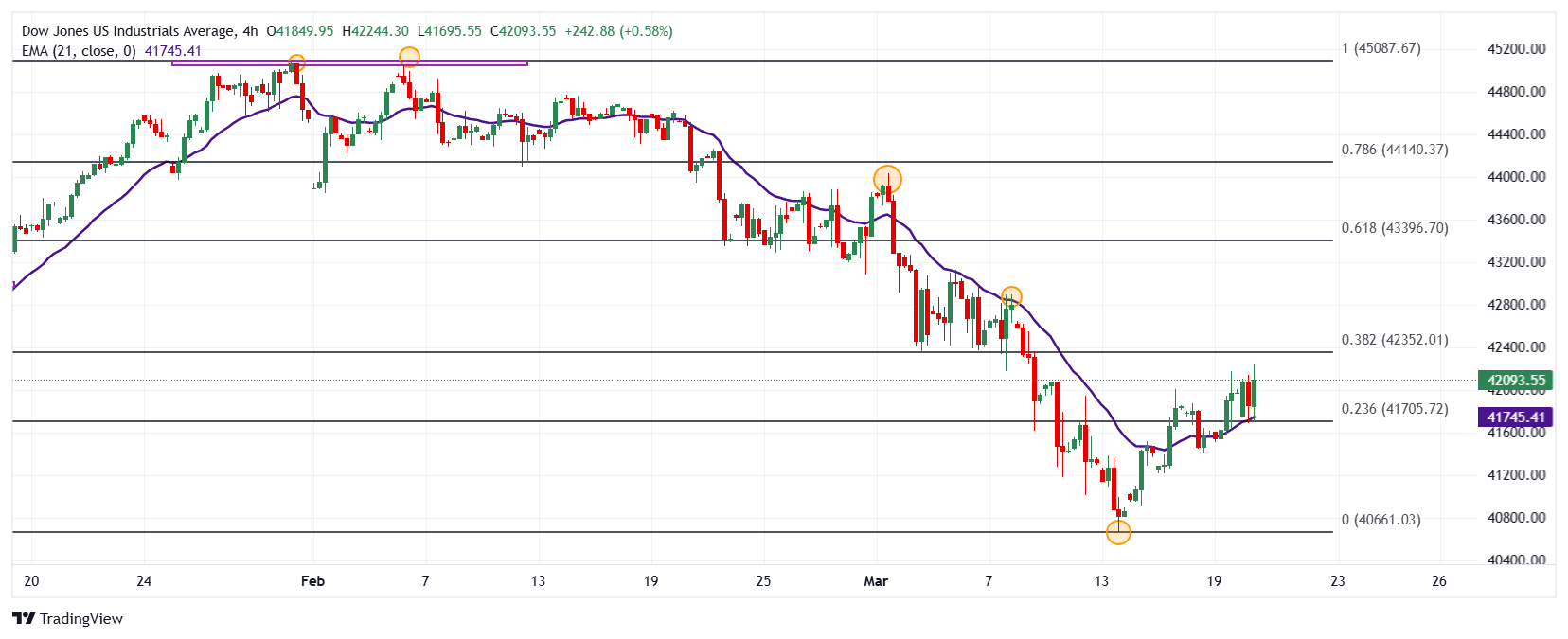- The Dow Jones rebounds 0.39% daily, reaching maximums of week and a half.
- The Nasdaq 100 rises 0.23% on Thursday, supported by goal Platforms (Meta) and Applovin Corporation (app).
- The S&P 500 wins 0.32% today, driven by Darden Restaurants (DRI).
- Weekly requests for unemployment subsidy rose to 223,000, below market forecasts.
The Dow Jones marked a minimum of the day in 41,684, where buyers attracted the index to a maximum not seen from March 10 in 42,244.
The Dow Jones industrial average began negotiations in 41,759 while the Nasdaq 100 technological index opened in 19,655. The S&P began operating in 5,637, spinning two consecutive sessions upwards.
The Dow Jones reaches maximums of more than a week animated by Sherwin-Williams and Home Depot
The Dow Jones index wins 0.39% on Thursday, going up 151 points, quoting at the time of writing about 42,118.
The Home Depot Titles (HD) rise 2.11% daily, reaching maximums of March 13 in $ 361.00, spinning is second consecutive session.
In the same tonic, Sherwin-Williams (SHW) values rebound 1.81%, reaching two days in 341.98 $.
In this context, Dow Jones extends its profits, visiting maximums not seen since March 10 in 42,244.
Meta Platforms and Applovin Corporation boost Nasdaq 100 to profit zone
The Nasdaq 100 technological index rises 0.23% daily, consolidating within the operational range of the previous session at 19,779.
Meta Platforms (target) shares recover 4.20% today, reaching maximums of March 17 in 609.61 $. On the other hand, Applovin (app) values extend their profits, rising 4.27% in the day, reaching maximums of March 17 in 313.00 $, thus signing its second consecutive day with profits.
The buying pressure takes control in the Nasdaq 100, aiming to exceed the key area of 20,000 in the short term.
The S&P 500 operates in positive terrain after the cautious posture of the Fed
The Federal Reserve kept interest ranks in a range between 4.25% – 4.50%, citing inflationary risks caused mainly due to tariff uncertainty. However, the points graph projects a position prone to cuts in the medium term, subject to the evolution of economic data.
According to the information presented by the United States Department of Labor, the weekly applications for unemployment subsidy increased by 223,000 in the week that concluded on March 14, being below the expected 224,000, although exceeding the 220,000 registered in the previous week.
Darden Restaurants (DRI) shares lead the profits in S&P 500, rising 6.25% on Thursday, reaching a new historical maximum in 203.47 $ after the publication of its quarterly report. DRI obtained revenues for 3.16 million dollars compared to the 3.21 billion expected dollars, as well as a gain per share of $ 2.80, slightly higher than the 2,796 projected by analysts.
The S&P 500 remains oscillating within the range of Wednesday’s session, spinning two consecutive sessions with profits in 5,690.
Technical Analysis of Dow Jones
The Dow Jones reacted upwards from a short -term support given by the minimum of March 13 in 40,660. The closest resistance is observed in 42,897, maximum of March 7, in convergence with the exponential mobile average of 21 periods. The next key resistance is 45,068, a pivot point of January 31.
4 -hour graph of Dow Jones

Dow Jones Faqs
The Dow Jones Industrial Avenge, one of the oldest stock market indexes in the world, consists of the 30 most negotiated values in the United States. The index is weighted by the price instead of capitalization. It is calculated by adding the prices of the values that compose it and dividing them by a factor, currently 0.152. The index was founded by Charles Dow, also founder of the Wall Street Journal. In recent years it has been criticized for not being sufficiently representative, since it only follows 30 companies, unlike broader rates such as S&P 500.
There are many factors that promote the Dow Jones Industrial Average (DJIA) index. The main one is the added performance of the companies that compose it, revealed in the quarterly reports of business benefits. The American and world macroeconomic data also contribute, since they influence investor confidence. The level of interest rates, set by the Federal Reserve (FED), also influences the DJia, since it affects the cost of credit, on which many companies depend largely. Therefore, inflation can be a determining factor, as well as other parameters that influence the decisions of the Federal Reserve.
Dow’s theory is a method to identify the main trend of the stock market developed by Charles Dow. A key step is to compare the direction of the Dow Jones Industrial Avenge (DJIA) and the Dow Jones Transportation Average (DJTA) and just follow the trends in which both move in the same direction. The volume is a confirmation criterion. The theory uses elements of maximum and minimum analysis. Dow’s theory raises three phases of the trend: accumulation, when intelligent money begins to buy or sell; Public participation, when the general public joins the trend; and distribution, when intelligent money abandons the trend.
There are several ways to operate with the DJ. One of them is to use ETF that allow investors to negotiate the DJ as a single value, instead of having to buy shares of the 30 companies that compose it. An outstanding example is the SPDR Dow Jones Industrial Avenge ETF (day). Future contracts on the DJ allow the specular operators about the future value of the index and the options provide the right, but not the obligation, to buy or sell the index at a predetermined price in the future. Investment funds allow investors to buy a part of a diversified portfolio of DJ values, which provides exposure to global index.
Source: Fx Street
I am Joshua Winder, a senior-level journalist and editor at World Stock Market. I specialize in covering news related to the stock market and economic trends. With more than 8 years of experience in this field, I have become an expert in financial reporting.







